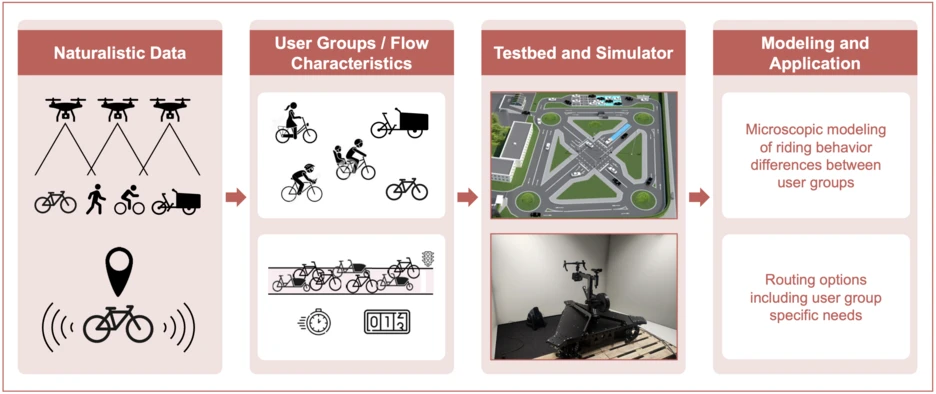| Usually, bicyclists are modeled as lane-based “small cars” but behave differently (e.g., different overtaking behavior or less lane discipline), therefore their representation in current simulation tools is not realistic. Also, all cyclists are treated identically; there is no representation of multiple user groups. In contrast, for motorized traffic there are specific models for different subgroups such as cars, buses, or trucks. This project aims to understand who is actually using the bicycle infrastructure and what requirements these users have. To this end, we will start with a comprehensive data collection of traffic observations, both stationary (bird’s eye view) and moving (floating bike observer from a user perspective). After that, we will analyze traffic flow characteristics from a micromobility point of view. Traditional traffic phenomena such as congestion or moving bottlenecks have mainly been investigated for motorized traffic, and fundamental diagrams for cyclists exist more or less only from simulated data. This is due to the fact that capacity drops, high flows, and high densities are rarely reached on any bicycle infrastructure so far. However, to describe bicycle traffic characteristics comprehensively as the basis for sustainable transportation planning, we need to know the parameters and phenomena also for infrastructure used by bicycles and other micromobility vehicles. Headways, acceleration behavior, overtaking maneuvers, etc. have been researched only in small trials. Our project aims to enrich the data collection with studies both at the Mobility Innovations Campus as a TUM test field and with various hardware simulators. These lab-based studies allow for the investigation of safety-critical maneuvers and also of infrastructure designs that do not yet exist in the real world. These studies will also reflect the heterogeneity of riders, vehicles, and (existing) bicycle infrastructure. Therefore, we will first need a characterization of riders and their vehicles before we can perform a macroscopic flow analysis and finally develop adapted bicycle models for multiple kinds of bicycle infrastructure environments. Further, we will develop measures to assess scenarios that increase the safety and efficiency of micromobility traffic, such as routing recommendations or network design aspects. |
